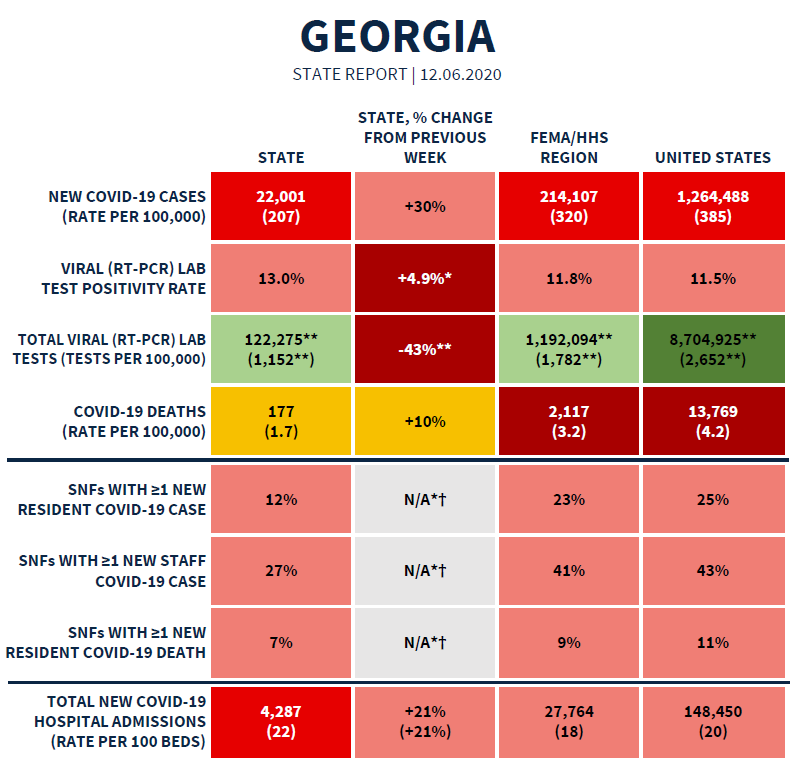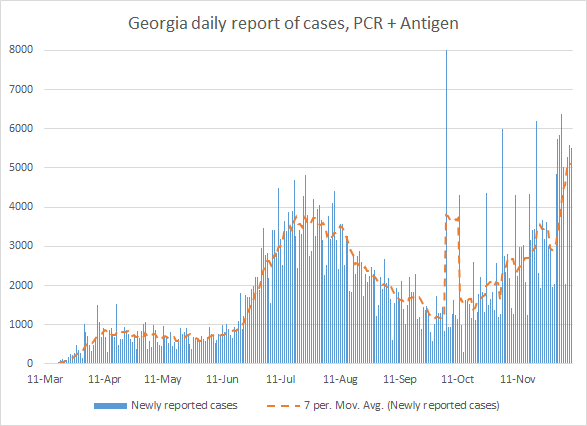The Daily Digest, 09Dec2020
Georgia COVID-19 Updates
Hello! I know I said that I would be writing the next vaccines segment here today but there are some new developments with the latest White House Coronavirus Task Force (WHCTF) report that I think merit some of our additional time. I may write a “catch up” letter tomorrow that focuses only on the vaccines or we’ll catch up over the next week or so. However, there is one development on the vaccine front that I do want to discuss today. Yesterday, Governor Kemp and Public Health Commissioner, Dr. Kathleen Toomey, held a pretty informative press conference regarding the plan for the vaccine as it arrives in Georgia, their thoughts on the latest surge, etc. In it they identified that Georgia will be receiving an initial shipment of vaccine that will not be enough to vaccinate all of the health care workers and long term care facility residents and staff that they had hoped to vaccinate. They hope to have enough doses to completely cover this initial target population by the end of January. It will be months, however, before the general public is vaccinated. So it is absolutely vital that we continue to wear masks, socially distance, and avoid exposure as much as possible.
Moving on to the WHCTF report, here’s the summary table. You’ll notice a lot of red - Georgia is not doing well, nor is the rest of the nation. Also notice that our percent positive rate has increased nearly 5% (and now exceeds the US average) while our testing output decreased by 43%. That’s not a good place to be as your pandemic is surging. After all, you can’t find disease if you’re not looking for it. Our death rate increased 10%.
We’re also above the national average now for new hospital admissions per 100 beds. Below, I’ve highlighted some of the WHCTF’s recommendations. Note that they are cautioning against ANY indoor gatherings outside of immediate households. And they want us to already be thinking ahead about December holidays and avoiding those gatherings with non-household contacts. They also recommend reduced capacity or closure of restaurants and bars.
Overall, Georgia is ranked 47th in the nation for new case rate per 100,000*** (red zone), #25 for PCR positivity (red zone), #18 for new COVID-19 hospital admissions per 100 beds (red zone), and #48 in the nation for new deaths per 100,000 (orange zone).
***This only considers PCR cases, so it’s sort of meaningless.
Testing
As mentioned in the introduction, the Georgia percent positive rate (blue line below) now exceeds the national rate. While our rate has ticked up 4.9 percentage points overall, it’s actually an even bigger increase compared to where we were last week - an increase of 62.5% in a single week. Our percent positive rate is skyrocketing, a sign that we aren’t testing widely enough to identify cases and the situation may be deteriorating rapidly. Meanwhile, Georgia is ranked #25 in the country for percent positive rate, in the red zone.
The counties with high percent positive rates are clustered in the northern half of the state and especially in the northeastern corner. But there’s also high positivity rates in what would be Hospital Region L, the I-75 corridor from Tifton to Valdosta.
And while our percent positive rate indicates we aren’t doing enough testing, the even worse news is that we are doing 43% less testing this week than we were the previous week. So not only are we not testing enough, we are trending in the wrong direction for testing output. But the problem is not unique to Georgia - it is impacting the overall national trend too.
Today in Georgia, it was a pretty small day for testing, just 22,681 new PCR test results reported compared to yesterday. Of those, 13.1% were positive. The Georgia DPH does not provide any data regarding antigen tests in terms of total tests performed nor how many were positive.
Cases
For cases, I want to start with the national map for new cases per 100,000 across the US. It is breathtaking to see so much red throughout the entire continental US. The number of counties in dark red (500+ cases per 100,000) is also alarming.
For Georgia, our new case rate is growing and it’s important to remember that Georgia only supplies the WHCTF with PCR-based cases. Antigen cases are not included whereas most states *do* report both. So Georgia’s numbers relative to others are falsely low, even as they are increasing. The state is ranked #47 in the nation for new case rate (in the red zone), but that ranking is pretty meaningless until we have an apples-to-apples comparison with other states that includes antigen cases. Because while we are #47 in the country for cases, all other indicators show we are in a much worse position - see the rankings for test positivity and hospital admissions per 100 beds.
Like percent positivity, a lot of the new cases per 100,000 are clustered in the northern half of the state.
The number of Georgia counties in the red zone has increased by 182% since mid-November. Seventy-nine percent of Georgia’s counties are in either the red, orange or yellow zones.
Today in Georgia there was a net increase of 5512 newly reported cases with 3744 by PCR and 1768 by antigen test. When you graph all laboratory positive cases, you can see that we are well above the height of the summer surge now. If we don’t get cases under control, the summer surge will look like a minor blip in the data, as the spring surge does now. In fact, if you consider total 7-day case rate per 100,000, the state case rate is now 31% above our summer surge peak. (Note: ignore the weird data spike around 11Oct - that’s the data dump of 26,000 antigen cases all at once by DPH)
An updated version of the Harvard Global Health Institute map that includes antigen cases can be found here. You’ll notice that most of the northern half of Georgia is shaded red, including all of the Atlanta metro (save for Clayton county). An updated 14-day case rate map that is formatted as similarly as I can get it to the DPH case rate map but including antigen cases can be found here. I apologize for not including images of the maps today in the newsletter, I recognize it’s another step for you to see them. But it’s a longer post than usual and I’m out of room.
Hospitalizations
There are new visualizations in the WHCTF report for new COVID-19 hospital admissions per 100 beds. I think looking at how things have intensified since Labor Day (“three months before” image below) is important.
For Georgia, our hospital admissions have increased in the most recent week. It’s notable that the hospital demand isn’t “just the elderly” (<—I do not condone this attitude), but the largest demand on our hospital admissions for COVID-19 are actually among middle-aged adults, aged 40-69. Another thing to note is that the proportion of admissions among the “unknown” category is growing. When demographic data collection is slipping, that could indicate that hospitals are being overwhelmed and/or that contact tracers are being overwhelmed. Meanwhile, the state is ranked #18 in the nation for new hospital admissions per 100 beds.
As far as PPE supply goes, there really isn’t much change compared to last week’s WHCTF report. Georgia still has about 15-18% of its hospitals reporting less than a week’s supply of different PPE resources on hand. This is better than where we were a month ago, but it’s not good to see this kind of inventory shortage when hospital admissions for Georgia are rising.
The WHCTF has included a new map for COVID-19 hospital admissions per 100 beds specific to the state. The data clustering is not based on counties or Georgia’s hospital regions, but how the Health and Human Services Protect Data hub has decided to divide up the state.
Today in Georgia we had a really high number of patients newly admitted to the hospital for COVID-19, 279. We haven’t had a number this high since 25Aug when we were coming down from the summer surge. There were 37 COVID-19 patients newly admitted to the ICU. There are now 2672 patients currently hospitalized in Georgia hospitals for COVID-19, a number we haven’t seen this high since 14Aug. Today, 86% of Georgia’s ICU beds are occupied, for COVID-19 and other reasons. Of Georgia’s 14 hospital regions, 10 of them are using more than 90% of their ICU beds today.
Deaths
Thankfully, the Georgia death rate remains 60% less than the national rate. That’s good news, for now. But our death rate is showing an increase over the most recent week. We’ll have to see whether this is just the noise of week-to-week variation (see earlier increases as the death rate declined overall for Georgia) or the beginning of a new surge in death rate. In the meantime, Georgia’s ranking for this metric has risen dramatically, from #44 in the nation (orange zone) in the 29Nov report to #18 in the nation (red zone) in the 06Dec report. Jumping 26 spots in a week’s time is pretty significant.
The map below shows where the new deaths per 100,000 (by date of report) are most concentrated. There are a lot of rural counties shaded in red.
Today in Georgia there were 46 newly reported confirmed deaths compared to yesterday and this is, unfortunately, an average day for the state. The updated statewide total is 9073. Thirty five percent of today’s deaths came from rural counties and another 33% came from nonrural counties. Twenty four percent came from Atlanta suburb counties.
References
Georgia White House Coronavirus Task Force report: https://beta.documentcloud.org/documents/20421380-georgia-12_6_20
Georgia Department of Public Health Daily Status Report: https://dph.georgia.gov/covid-19-daily-status-report
Georgia Geospatial Information Office COVID-19 Data Hub: https://covid-gagio.hub.arcgis.com/
Governor Kemp / Commissioner, Dr. Kathleen Toomey press conference: https://www.gpb.org/events/news/2020/12/08/governor-kemp-and-officials-give-coronavirus-update-12820
Georgia COVID-19 Updates is a free newsletter that depends on reader support. If you wish to subscribe please click the link below. There are free and paid options available.
My Ph.D. is in Medical Microbiology and Immunology. I've worked at places like Creighton University, the Centers for Disease Control & Prevention and Mercer University School of Medicine. All thoughts are my professional opinion and should not be considered medical advice.















